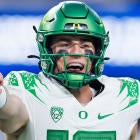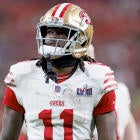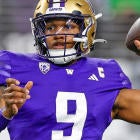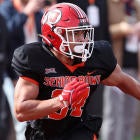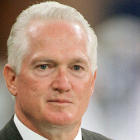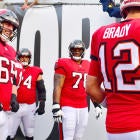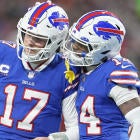"He's a product of the system."
You hear this phrase every year, typically in the lead-up to the NFL Draft, but also when discussing the exploits of some current NFL quarterbacks. It's a label that was applied most recognizably to Marcus Mariota and Bryce Petty this year, but also to quarterbacks as disparately talented as Johnny Manziel, Cam Newton, Robert Griffin III and even Aaron Rodgers in the past.
“I think he has a good chance of being a bust. Just like every other (Jeff) Tedford-coached quarterback,” one NFC scout told the Journal Sentinel’s Bob McGinn before Rodgers was drafted back in 2005. “He’s a system quarterback,” an AFC scout told McGinn at the time. “3-, 5-, 7-step guy. Can’t create on his own. Panics under pressure. Gets flustered easy.”
Using the "system quarterback" terminology is mostly just a way to a knock a player who threw his collegiate passes out of the so-called spread offense, a way of "not saying, just saying" that the quarterback will not be able to succeed at the NFL level because he won't be able to pick up the pro-style offense.
Here's a news flash: while some college versions of the spread may make it difficult to evaluate quarterback prospects, a modified version of it is also becoming the preferred pro-style offense, more and more with each passing season.
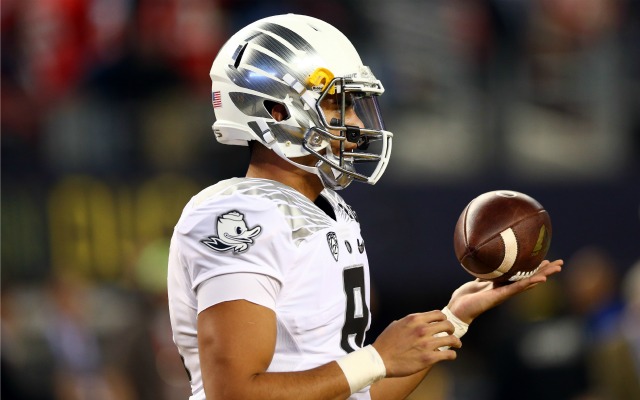
Let's walk through some of the characteristics of the spread, as well as the concerns leveled on the shoulders of spread QBs coming out of college, to show just how this is happening.
Heavy usage of single-back, multi-receiver sets
The NFL has been heading this way for years. And over the last few, it's become more and more prevalent. Fullbacks rarely see the field anymore; only seven teams used one for more than 250 snaps last season (less than half the number of teams that did so in 2011, just three seasons earlier), and not a single one featured a fullback on more than half its plays.
| Snaps in single or empty backfield formation | |
| Year | % of Snaps |
| 2011 | 69% |
| 2012 | 72% |
| 2013 | 76% |
| 2014 | 80% |
Single and empty back sets have become the dominant formation in the NFL. And it's not as though every team is removing the fullback and going with 12 personnel (two tight ends). They're taking that guy off the field mostly to add an additional wide receiver.
| Snaps with 3+ WRs on field | |
| Year | % of Snaps |
| 2011 | 49% |
| 2012 | 51% |
| 2013 | 56% |
| 2014 | 59% |
These figures, via Football Outsiders, are actually underestimating the amount of time that NFL teams actually spend in three-plus wide receiver sets because they don't include snaps where a tight end, running back or H-Back splits out wide. Those plays also generate more yards on a per-play basis than those featuring multiple backs or tight ends, though obviously some of that is affected by the usage of multi-back or multi-tight sets close to the goal line, where yards are inherently depressed.
Heavy, near-exclusive use of the shotgun
One major concern often leveled against spread quarterbacks coming out of college is that they never take snaps from under center. The pro-style offense is a big change for them because they'll have to be under center all the time, the thinking goes. Well, NFL quarterbacks are increasingly moving back a few yards to take the snap out of the shotgun, just like their college counterparts.
| Snaps in shotgun | |
| Year | % of Snaps |
| 2011 | 41% |
| 2012 | 49% |
| 2013 | 57% |
| 2014 | 61% |
And those figures just represent the percentage of total snaps taken out of the shotgun. Per a study conducted by ESPN, while 69.4% of all NFL dropbacks started from under center as recently as 2006, that number plummeted all the way to 21.9% during the 2014 season. Basically, at the same time the NFL is becoming more and more concerned with the fact that quarterback prospects don't take snaps from under center, coaches are having their own quarterbacks take fewer and fewer snaps, and make a lower and lower percentage of their throws, from under center. That seems somewhat illogical.
And not only are plays from the shotgun becoming more and more common, but they are also more efficient than those from under center.
| Yards Per Play | ||
| Year | Shotgun | Under Center |
| 2011 | 6.1 | 5.2 |
| 2012 | 6.0 | 5.1 |
| 2013 | 5.9 | 5.0 |
| 2014 | 6.0 | 5.0 |
| Four-Year Average | 6.0 | 5.1 |
Shotgun plays have averaged nearly a yard per play more than plays from under center in each of the last four years, and over the last four years combined. Much of this is because more passes are thrown from shotgun than under center, as stated above, but shotgun runs have generally averaged more yards per play than those from under center as well. Operating out of the gun is a more efficient proposition in basically every situation.
Quick, single-read throws that don't require reading progressions
This is a tough one to break down. Reading NFL defenses is arguably the toughest part of the transition for any college quarterback making the jump to the NFL level. But a lot of that reading is done pre-snap, with the best of the bunch diagnosing the coverage in order to get the ball out quickly, avoid a sack and put it into the hands of a receiver or running back that can make something happen. Over the last few years, quarterbacks have been getting the ball out more quickly than ever before, indicating that the NFL, too, is trending toward becoming a quick-read league.
Football Outsiders has tracked "time to throw" stats since 2011, breaking every throw down into two separate categories: throws in under 2.5 seconds after the snap, and throws 2.5 seconds or more after the snap.
| Time to Throw | |
| Year | % of throws in Under 2.5 seconds |
| 2011 | 55.90% |
| 2012 | 55.19% |
| 2013 | 56.56% |
| 2014 | 58.55% |
Why are more and more throws coming out quickly? Well, because they're more efficient, of course.
| Completion % by release time | ||
| Year | Under 2.5 seconds |
2.5 seconds or more |
| 2011 | 64.6% | 55.0% |
| 2012 | 66.3% | 54.8% |
| 2013 | 66.8% | 54.4% |
| 2014 | 68.7% | 54.7% |
There will obviously be occasions where the quarterback has to hold onto the ball simply because nobody immediately flashes open. And in those cases, there is nothing more important than being able to manage the rush, read your progressions, and find the open receiver. But that's something that affects nearly every quarterback in the NFL in extreme ways, to the point that leaguewide completion percentage dropped off 14.0% last season based on the under/over 2.5 seconds after the snap designation. That's the widest discrepancy in the last four years, as the gap keeps getting wider.
It's a distinction that affected everyone from Aaron Rodgers (72.0% to 56.3%) to Colin Kaepernick (68.8% to 47.3%) and Tom Brady (71.5% to 52.1%) to Alex Smith (72.3% to 54.2%). Even the quarterbacks that were among the least affected -- Peyton Manning (68.2% to 63.5%), Tony Romo (73.5% to 68.0%), Eli Manning (67.4% to 58.4%), Cam Newton (63.3% to 54.2%) -- came from a mixture of spread and more traditional offenses.
None of this is to say reading progressions doesn't matter. Of course it does. After accuracy, it may be the single most important quarterback skill. It's just that the league is rightly trending toward getting the ball out quickly, and quarterbacks of all stripes struggle when forced to hold the ball past when they'd normally throw to their first read. Good quarterbacks make the necessary adjustments before the snap so they already know where the ball is going once they begin their drop; great ones do that, and then are also able to change course if that adjustment doesn't result in an immediately open target.
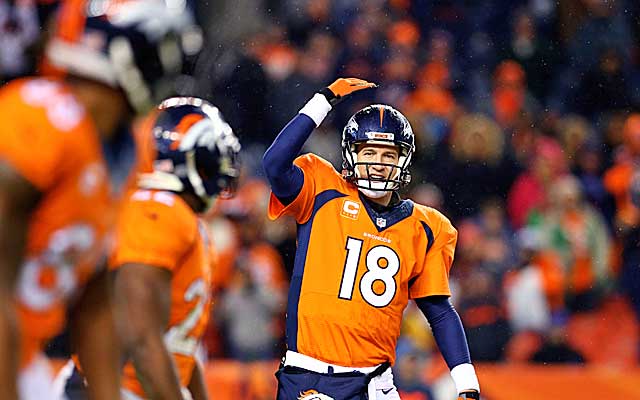
They aren't used to calling plays in the huddle
This is a fairly new criticism that came up this year as Mariota emerged as one of the top draft prospects. Oregon's offense -- along with numerous other spread offenses in college -- uses a play-card system that signals in plays from the sideline while the team rushes up to the line of scrimmage, rather than the more traditional NFL style of play-calling where the head coach or offensive coordinator uses a radio connected to the quarterback's helmet to relay the call, and the quarterback then disseminates that call to the other 10 players in the huddle.
Cardinals coach Bruce Arians was vocal about this point. “Seeing the guys coming out of the systems now where the coach holds a card up, the players line up, he kicks his foot and they play football -- the hardest thing for them is to get into a huddle and call a play,” Arians said. “They’re stuttering, they’re stammering, the guys around them don’t believe in them. That’s that leadership thing. That’s the hardest thing for these young quarterbacks who play in these systems … they have to learn how to play quarterback at this level and sometimes that’s overwhelming.”
It should be noted here that college quarterbacks don't have the benefit of radio communication from their coaches like NFL quarterbacks do, which makes it difficult to radio in a play call to them. Additionally, the NFL is increasingly becoming a no-huddle oriented league. No-huddle usage more than doubled from 2011 and 2013 alone, rising from 5.7% of snaps in 2011 to 6.7% in 2012, to 12.2% in 2013. Even more teams used it in 2014, and though I wasn't able to find a confirmed percentage breakdown, the percentage of no-huddle snaps taken is doubtlessly higher than it was the year before, and next year it will be higher still.
Look at all the teams that have professed an interest in using more of the no-huddle next season. First, there's the Raiders. Head coach Jack Del Rio believes it will allow them to be more diverse on offense and vary their tempo. Then there's the Carolina Panthers. Riverboat Ron Rivera recognized how much more effective Cam Newton was down the stretch of last season when the team went no-huddle, and wants to do it more this year. The Buccaneers are expected to run more no-huddle under offensive coordinator Dirk Koetter.
These stories come on the heels of teams like the Chargers, Colts and Steelers announcing (and mostly following through on) plans to run more no-huddle before last season. Browns coach Mike Pettine called the no-huddle the future of the league. Add all those teams to Peyton Manning's Broncos, Bill Belichick and Tom Brady's New England Patriots and of course, Chip Kelly's Philadelphia Eagles, and you've got the makings of a leaguewide trend toward less huddling that's already reflected in recent data. What's more is that no-huddle plays have historically been -- you guessed it -- more efficient than those run after teams huddle up.
There are advantages (more time for the quarterback to read the defense and get into the optimal play call, tired defenses that aren't allowed to change personnel groupings, the need for the opposing team to devote valuable practice time to learning how best to defend no-huddle offenses) and disadvantages (difficulty communicating plays across the entire field, short drives if you don't get a first down, more time spent on the field for your defense) to the no-huddle, but by and large it's becoming more prevalent with each passing season, and it's an effective strategy if you play it correctly. You don't have to run up to the line of scrimmage and snap it with 20 seconds on the play clock like the Eagles, either. Peyton Manning's teams rarely huddle, but also rarely snap the ball before there are five or fewer seconds on the play clock. It can be used simply to keep your team in favorable personnel groupings while also controlling the pace of play.
NFL coaches have also known this would happen for a good, long while. Bill Walsh, the Godfather of the West Coast Offense, wrote the following in his book, Finding the Winning Edge, about the future of NFL offenses:
- Teams will huddle only when the clock is stopped.
- Teams will use single-world offensive audibles.
- The quarterback will receive direction from the coach at the line of scrimmage. Because the ball can be put into play at any moment, the defense must commit itself with its front and coverage.
- The quarterback will look to the sideline the instant the whistle blows on the previous play to see which personnel combination is entering the game. The designated coach indicates the formation to the quarterback and whether he should audible his own play or will receive a play call from the coach. All of these steps will occur without a huddle.
- The quarterback will have even more latitude in audibling at the line of scrimmage. His decisions will override those by the coach signaling in a play call.
That sounds a whole lot like the spread, no-huddle offense run by, say, the Patriots, who famously use a one-word system for calling plays when they do go no-huddle that Belichick adopted from college offenses. That certainly makes it easier to communicate the calls, and it again gives Brady more time to read the defense at the line of scrimmage without having to blurt out a mouthful of a play call.
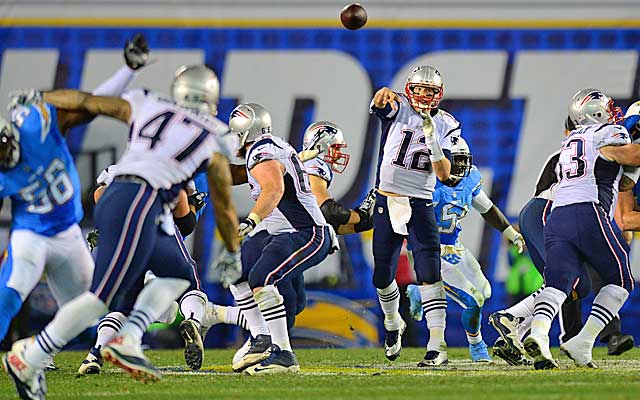
Conclusion
With NFL teams increasingly incorporating elements of spread offenses into their own, and with those specific tactics generally being more efficient than "the way things have always been done," maybe it just shouldn't be as much of a concern as it seems to be in NFL circles.
College-style spreads, with their wider throwing lanes and larger emphasis on quarterback runs, make it somewhat difficult to evaluate quarterback prospects, sure, but the NFL has historically not been all that great at evaluating quarterback prospects in pro-style offenses, either. The hit rate on quarterback draft selections is the lowest of any position.
Those trends also beg a more interesting question: shouldn't NFL offenses be built around the skill set of the quarterback, and not the other way around? If you're betting the future of the franchise in a player, the goal should be to give him the best chance possible to succeed. If that means crafting an offense that features lots of shotgun, multi-wide, no-huddle plays that rely on quick decisions, why not do it?













